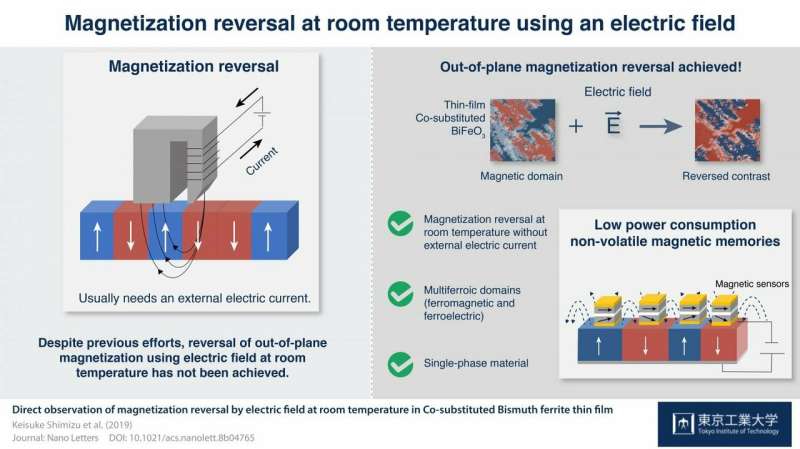Magnetization reversal achieved at room temperature using only an electric field

Scientists at Tokyo Institute of Technology have achieved magnetization reversal in cobalt-substituted bismuth ferrite by applying an electric field. Researchers have sought such a technique for over a decade in order to make new types of low-power-consumption magnetic memory devices.
In the era of information technology revolution, electronics demand rapid evolution facilitated by greater efforts from materials researchers. In particular, a better understanding of the electromagnetic properties of materials and new ways to harness them would allow for the fabrication of devices based on such principles.
Two years ago, a research team from the Laboratory for Materials and Structures at Tokyo Institute of Technology (Tokyo Tech), led by Prof. Masaki Azuma, demonstrated promising properties of Cobalt-substituted Bismuth ferrite (BFCO). This peculiar material exhibits both ferroelectric and ferromagnetic properties at room temperature; the team inferred that these are coupled in a way that could be exploited to exhibit reversal of the magnetization of the material by application of an electric field at room temperature without the need of electric current.
In a more recent study, the team presented proof of this hypothesized magnetization reversal in thin films of BFCO at room temperature. While previous researchers saw some success in achieving magnetization reversal, their results were for in-plane magnetization on a multi-layer material, which carries some disadvantages. "Direct observation of magnetization reversal on a single-phase material with ferroelectric and ferromagnetic orderings is crucial to the study of the intrinsic coupling between them. Moreover, out-of-plane magnetization reversal is desirable from the viewpoint of integration," explains Azuma.
Thus, the team fabricated thin BFCO films that exhibited spontaneous magnetization. Because BFCO is very sensitive to lattice strain, these thin films were grown on orthorhombic GdScO3, whose lattice structure matches that of BFCO maximally and bolsters the growth of highly crystalline films with minimal lattice strain. After verifying the presence of the out-of-plane magnetization, the team went on to investigate the correlation between the ferromagnetic and ferroelectric domains to see if magnetization reversal was possible by switching electric polarization.
In the resulting piezoelectric force microscopy and magnetic force microscopy images, the researchers found that their attempts were successful and that it was, indeed, possible to achieve out-of-plane magnetization reversal using an electric field at room temperature. This represents the first time that such a feat has been carried out, and could soon become the operating principle of a new type of memory device.
Azuma says, "The current demonstration of magnetic reversal using an electric field paves the way to low power-consumption, non-volatile magnetic memories, such as magnetoresistive random-access memories."
More information: Keisuke Shimizu et al, Direct Observation of Magnetization Reversal by Electric Field at Room Temperature in Co-Substituted Bismuth Ferrite Thin Film, Nano Letters (2019). DOI: 10.1021/acs.nanolett.8b04765
Journal information: Nano Letters
Provided by Tokyo Institute of Technology





















